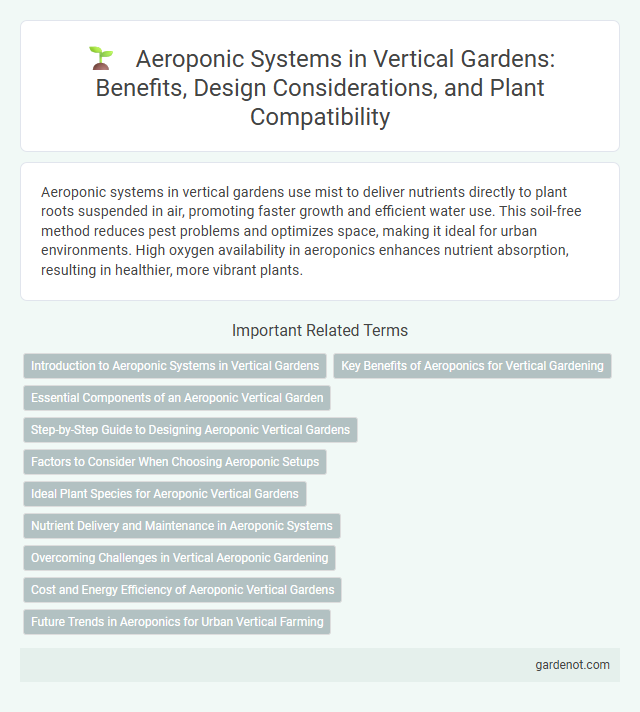Aeroponic systems in vertical gardens use mist to deliver nutrients directly to plant roots suspended in air, promoting faster growth and efficient water use. This soil-free method reduces pest problems and optimizes space, making it ideal for urban environments. High oxygen availability in aeroponics enhances nutrient absorption, resulting in healthier, more vibrant plants.
Introduction to Aeroponic Systems in Vertical Gardens
Aeroponic systems in vertical gardens use nutrient-rich mist to deliver water and essential minerals directly to plant roots, promoting faster growth and higher yields compared to traditional soil methods. This soil-free cultivation technique reduces water usage by up to 90%, making it highly efficient and sustainable for urban farming. Vertical aeroponic gardens optimize space and improve air circulation, enhancing plant health and maximizing crop density in limited areas.
Key Benefits of Aeroponics for Vertical Gardening
Aeroponic systems in vertical gardening significantly enhance plant growth by delivering nutrient-rich mist directly to roots, optimizing oxygen exposure and nutrient absorption. This soil-free method reduces water usage by up to 90%, promoting sustainable urban agriculture with minimal resource input. The controlled environment of aeroponics also decreases disease risk and enables faster harvest cycles, boosting overall yield and efficiency in vertical gardens.
Essential Components of an Aeroponic Vertical Garden
An aeroponic vertical garden relies on essential components including a misting system that delivers nutrient-rich water directly to the plant roots suspended in air, optimizing oxygen absorption and nutrient uptake. The framework supports plants vertically, maximizing space efficiency, while reservoir tanks and pumps regulate the flow of the nutrient solution. Precise environmental controls like humidity, temperature, and light sensors ensure optimal growth conditions within the vertical structure, enhancing plant health and productivity.
Step-by-Step Guide to Designing Aeroponic Vertical Gardens
Design an aeroponic vertical garden by first selecting a sturdy, vertical frame that maximizes space for plant growth above ground. Integrate a high-pressure misting system to deliver nutrient-rich water directly to plant roots suspended in the air, ensuring optimal oxygen availability and nutrient absorption. Monitor environmental factors such as humidity, light, and temperature to maintain ideal growth conditions and maximize crop yield in limited spaces.
Factors to Consider When Choosing Aeroponic Setups
When selecting an aeroponic system for a vertical garden, prioritize factors like misting frequency, nozzle type, and root chamber design to ensure optimal nutrient delivery and oxygenation. Consider the system's power consumption and water usage efficiency, as these impact sustainability and operating costs. Compatibility with plant species and ease of maintenance are critical to maximize growth performance and reduce downtime.
Ideal Plant Species for Aeroponic Vertical Gardens
Lettuce, spinach, and herbs such as basil and mint thrive in aeroponic vertical gardens due to their lightweight structure and fast growth. Strawberries and cherry tomatoes also perform well, benefiting from the efficient nutrient delivery and oxygenation of the roots. Leafy greens and small fruiting plants optimize space and resource use in aeroponic systems, ensuring high yield and quality.
Nutrient Delivery and Maintenance in Aeroponic Systems
Aeroponic systems deliver nutrients by misting plant roots with a highly oxygenated, nutrient-rich solution, ensuring efficient absorption and rapid growth. Maintenance involves regular monitoring of nutrient concentration, pH levels, and misting nozzles to prevent clogging and disease. Automated sensors and timers optimize nutrient delivery cycles, reducing water waste and enhancing plant health in vertical gardens.
Overcoming Challenges in Vertical Aeroponic Gardening
Vertical aeroponic gardening faces challenges such as nutrient delivery inconsistencies, root aeration, and water management. Advanced misting technologies and automated nutrient dosing systems enhance nutrient absorption and prevent root desiccation. Integrating sensor-driven environmental controls optimizes growth conditions, ensuring higher crop yields and resource efficiency in vertical aeroponic setups.
Cost and Energy Efficiency of Aeroponic Vertical Gardens
Aeroponic vertical gardens offer significant cost savings by using up to 90% less water than traditional soil-based systems, reducing overall resource expenditure. Energy efficiency is enhanced through precise control of nutrient delivery and optimized airflow, minimizing power consumption while promoting rapid plant growth. These systems lower operational costs by reducing water and nutrient waste, making aeroponic gardens an economically sustainable option for urban agriculture.
Future Trends in Aeroponics for Urban Vertical Farming
Future trends in aeroponics for urban vertical farming emphasize enhanced nutrient delivery systems and AI-driven environmental controls to maximize crop yield and resource efficiency. Integration of IoT sensors enables real-time monitoring of root zone oxygen levels and moisture, promoting healthier plant growth with minimal water usage. Advances in aeroponic technology aim to reduce energy consumption and footprint, making urban food production more sustainable and scalable.
Aeroponic system Infographic

 gardenot.com
gardenot.com